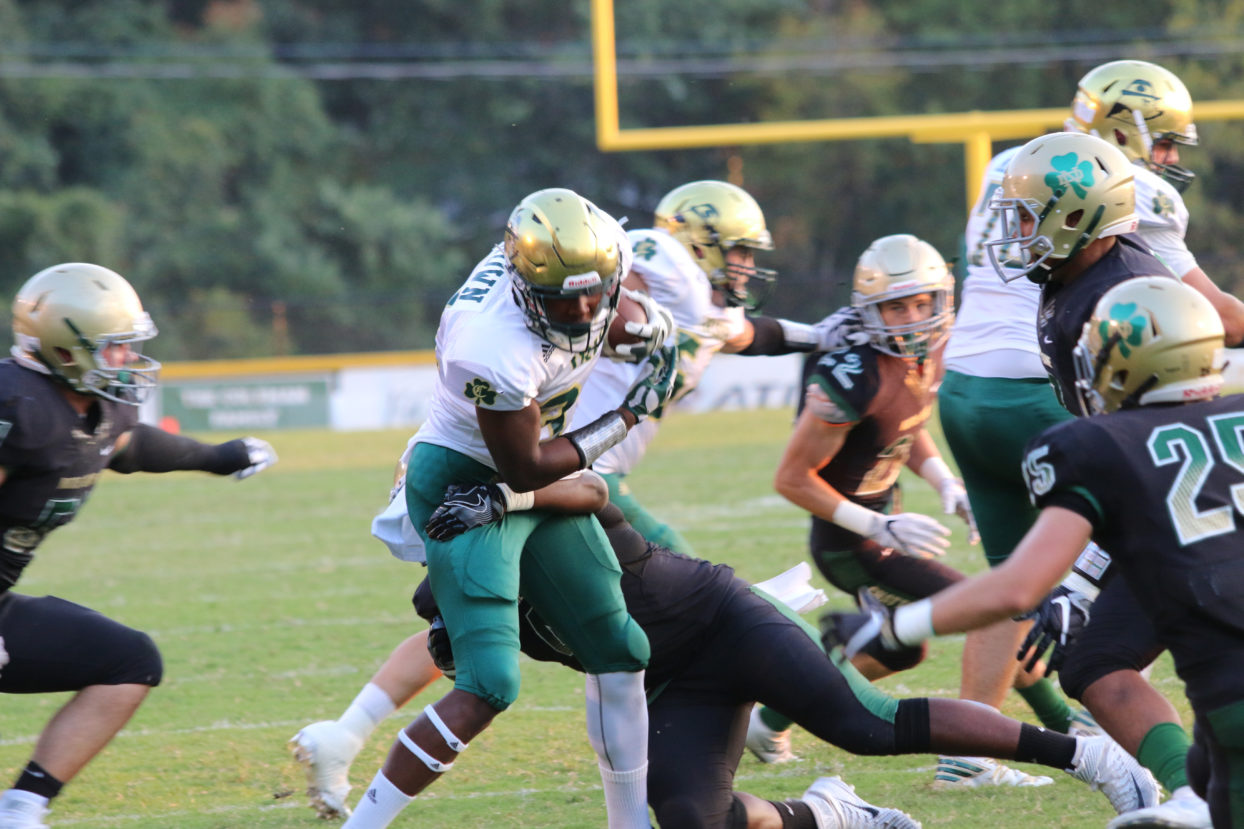By Dan McWilliams
The diocese’s two high schools reached an athletics crossroads this fall when they had to decide whether to remain in Division I, the non-financial-aid division, or move to Division II.
Each high school made a different choice.
Knoxville Catholic High School opted to stay in Division I, while Notre Dame High School moved to the financial-aid Division II.
KCHS made its decision mainly for travel reasons, as moving to D-II could have resulted in costly regular-season trips to Nashville and Memphis in all sports. The school learned that fact after a July meeting of the TSSAA Board of Control determined enrollment classifications for D-I and D-II.
“It became apparent to us that we wouldn’t have a regular-season opponent in any sport that was closer than 100 miles away,” KCHS president Dickie Sompayrac said. “When you start factoring in going to Nashville on a Tuesday night for a basketball game—typically basketball games don’t start until 8 or 8:30. Well, if we’re on Central Time, now that’s 9 or 9:30 for our kids. Let’s say we went to Father Ryan [in Nashville]. We could play a 2-hour, 2-hour-and-15-minute basketball game, shower, get a bite to eat—you’re not on the road and coming home until 11:30 at night. Kids have got homework.
“I think from just the health of our students and academically and financially for our school, going Division II would be a terrible decision. Ultimately that’s what led to us making the decision to stay in Division I.”
The decision was a hard one because KCHS does provide financial aid to some students. But those students, by the rules of D-I, cannot play varsity sports, only junior varsity. If KCHS was D-II, those students could play varsity sports.
“Honestly [the decision] was tough just because from a standpoint of mission—I don’t like playing in a division where we have to tell families that hey, your son or daughter won’t be able to play if you don’t make enough money to pay full tuition,” Mr. Sompayrac said. “I think that’s a tough thing. We have kids walking our halls right now that are not playing varsity sports because their parents have no other option but to accept financial aid, which makes them ineligible to play varsity athletics. I don’t like that that happens, but right now, given the alternative, staying in Division I is the best move for our school.”
The head coach of Knoxville Catholic’s football team, Steve Matthews, agreed that travel was the biggest reason for staying in Division I.
“That’s right, especially when you consider all of the other sports involved. I sat in on a few of the discussions, but for the most part, I don’t think football was a huge factor in the decision. I don’t think football was a big deal when it came to the decision—it had more to do with baseball, basketball, lacrosse, and soccer. Traveling would have definitely been an issue.”
As it turns out, Knoxville Catholic still will have to travel a good bit in football as it was placed in Region 4-5A with Lenoir City, Walker Valley [Cleveland], Soddy-Daisy, and Rhea County.
A drawback of KCHS’s placement in a small region is that it has only four region games, meaning the Irish will have to find six non-region opponents to fill out a 10-game schedule.
“I think the biggest disappointment for us, from a football perspective, is we weren’t surprised that we got sent to Chattanooga,” Mr. Sompayrac said. “We just were hoping that the TSSAA would put more teams in our region, because it’s going to be very hard for us—because being in a five-team district in football means we have six non-district games. That’s going to be very tough for Coach Matthews to schedule six non-district games. That was disappointing.”
The head coach agreed.
“We were a little disappointed with having to go to Chattanooga for the bulk of our games, but no doubt it’s not even close to what would have happened [in D-II],” Mr. Matthews said. “The difficult part now is finding non-region games. With the success we’ve had in football the last few years, it’s typical for teams like us and other teams with big-time winning records—sometimes it’s difficult to find games.”
As he works on his 2017-18 football schedule over the next few weeks, Mr. Matthews may consider playing only nine games instead of the usual 10.
“You never know. I’ll see what happens,” he said. “This day and age you hope to go deep in the playoffs, and there’s a part of me that thinks there’s maybe too many games already, when you’re talking 10 regular-season and then five playoff games. These are young men, and that’s a lot of football to be played. To me that’s not the end of the world if that [nine games] ends up happening.”
KCHS has none of its region rivals from the last two years, including Fulton and Knoxville Central, in its new region, meaning it would have to pick them up as non-region opponents or go farther afield for non-region foes. KCHS and Rhea County, led by former Irish head coach Mark Pemberton, have already had to schedule out-of-state opponents the last two years just to fill a 10-game slate without the tougher restrictions of a smaller region they now face.
In basketball, baseball, and softball, KCHS will have more local competition in District 4-AAA in Bearden, Farragut, Hardin Valley, Heritage, Lenoir City, Maryville, Knoxville West, and William Blount. The Irish also will have mostly local opponents in the smaller sports.

Knoxville Catholic High School quarterback Chase Cunningham looks to throw the ball before Notre Dame defensive end James Williams arrives in this fall’s Irish Bowl.
“It’s really the other sports [besides football] where [going to D-II] would be detrimental,” Mr. Sompayrac said. “In the other sports, the only two teams east of Nashville that we could play would be [Chattanooga’s] Baylor and McCallie and then GPS [Chattanooga’s Girls Preparatory School] for the girls sports, and the rest of our regular-season competition would be in Nashville. When you look at sports like softball, baseball—we’re in a division, albeit it’s a tough one, with Farragut, Bearden, Maryville, Hardin Valley, which is local. We would rather play a local schedule any day of the week.”
Notre Dame president George Valadie said his school has been in Division II before, but the “practical side” of the argument—more travel in D-II—led to a return to D-I in recent years.
“[NDHS] found itself in a position in Chattanooga where there were, after a couple of years, no other Division II schools in the city in our enrollment level,” Mr. Valadie said of the school’s earlier time in D-II. “We do have three other Division II schools, Baylor, McCallie, and GPS, but they are not in our enrollment level. So Notre Dame found itself in a position where there was nobody else in Chattanooga in their enrollment classification of Division II, which meant that Notre Dame would be traveling a lot for its competition.
“We made the [original] decision to be in Division II because it’s always been part of what we wanted to do: to help people financially. However, as much as that is what we’ve always wanted to do, we had to look at the practical side of where we would be. The practical side said we would find ourselves going to Nashville on a Tuesday night to play basketball. The practical side says, if there’s nobody to play in your city, then you must travel to Nashville, thus we would find ourselves traveling to Nashville on a Tuesday night to play basketball, and getting home late, and our kids having two or three tests the next day. The practical side was not acceptable. So there came a point in time when Notre Dame left Division II and went back to Division I, and that’s where we have been.”
In the latest realignment, Notre Dame football has been placed in the East Region of Class AA with local teams Boyd Buchanan, Chattanooga Christian, and Silverdale Baptist Academy plus Christian Academy of Knoxville, Grace Christian Academy of Knoxville, and Webb School of Knoxville. That makes for a few Knoxville trips for the Fighting Irish gridiron team.
“We may have to do a little traveling; we knew that,” Mr. Valadie said. “The reason we’re going back to Division II was, it’s what we’ve always wanted to do, but the practical side was improved. If you look at the schools in our area, there are now Chattanooga schools involved in our enrollment classification, and we may still have to travel some, but it’s not nearly what it would have been.”
There’s a “second side” to NDHS’s decision, Mr. Valadie said, involving a type of financial aid the school provides.
“The TSSAA has allowed private schools to work with parents, and they can do work for the school and earn some tuition dollars,” he said. “Now that has been acceptable. It wasn’t classified as financial aid, but now it is. It is going to be classified as financial aid, and we do have a number of families who have been working to gain tuition dollars. So moving to Division II helps them out, and it allows us to also give aid where we can, and the practical side is greatly improved.”
Notre Dame will largely have more local competition in basketball, baseball, softball, and the other sports.
Knoxville Catholic’s enrollment is 619, which would normally place it in a lower classification, but because it is a D-I independent school its enrollment is multiplied by 1.8 for the purposes of classification. That results in a total of 1,114, which barely puts KCHS into Class 5A (1,103 to 1,508 students) in football.
Notre Dame’s enrollment is 420 and is not multiplied because it is in Division II. ■

